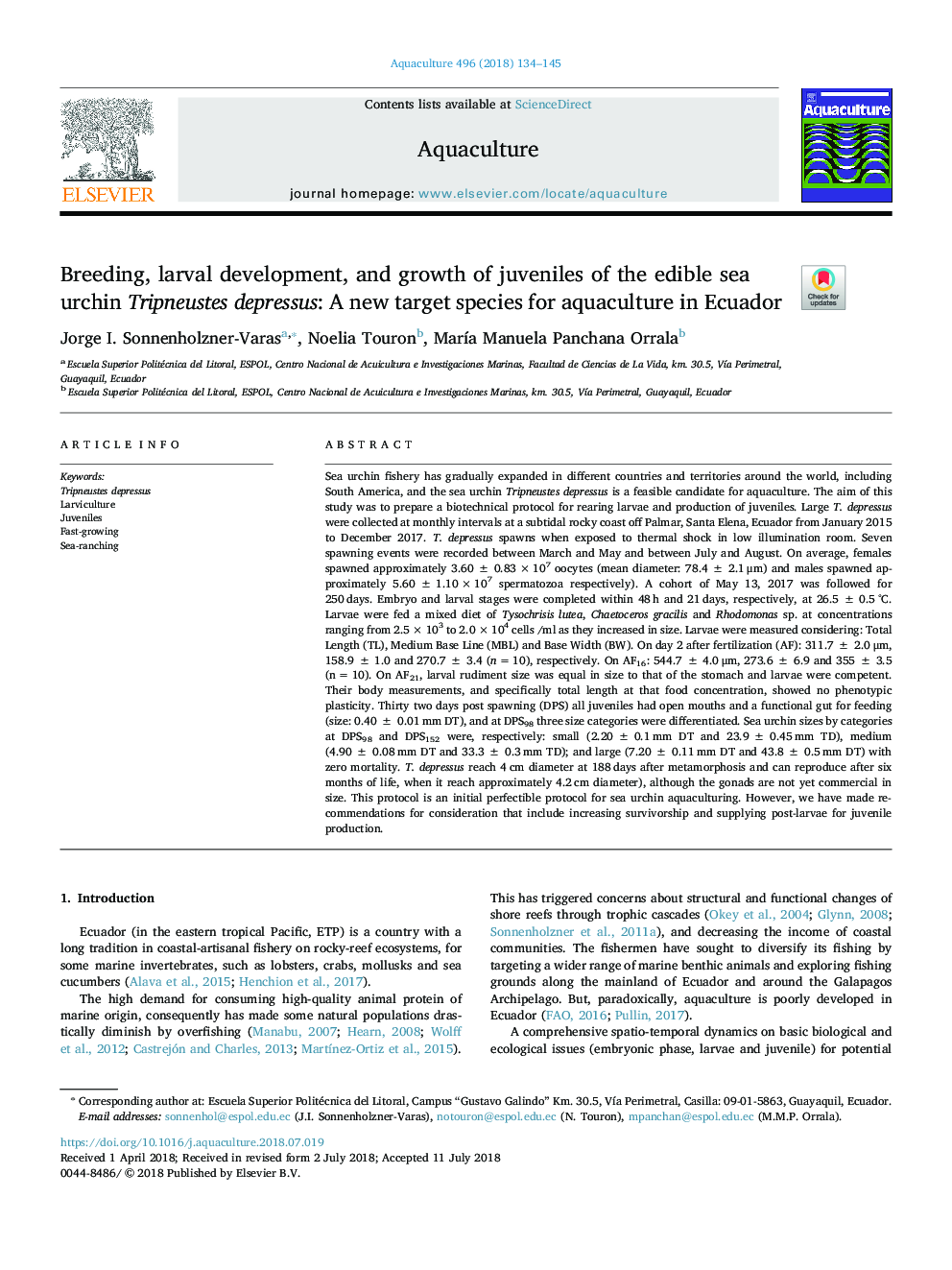| کد مقاله | کد نشریه | سال انتشار | مقاله انگلیسی | نسخه تمام متن |
|---|---|---|---|---|
| 8492963 | 1552792 | 2018 | 12 صفحه PDF | دانلود رایگان |
عنوان انگلیسی مقاله ISI
Breeding, larval development, and growth of juveniles of the edible sea urchin Tripneustes depressus: A new target species for aquaculture in Ecuador
دانلود مقاله + سفارش ترجمه
دانلود مقاله ISI انگلیسی
رایگان برای ایرانیان
کلمات کلیدی
موضوعات مرتبط
علوم زیستی و بیوفناوری
علوم کشاورزی و بیولوژیک
علوم آبزیان
پیش نمایش صفحه اول مقاله

چکیده انگلیسی
Sea urchin fishery has gradually expanded in different countries and territories around the world, including South America, and the sea urchin Tripneustes depressus is a feasible candidate for aquaculture. The aim of this study was to prepare a biotechnical protocol for rearing larvae and production of juveniles. Large T. depressus were collected at monthly intervals at a subtidal rocky coast off Palmar, Santa Elena, Ecuador from January 2015 to December 2017. T. depressus spawns when exposed to thermal shock in low illumination room. Seven spawning events were recorded between March and May and between July and August. On average, females spawned approximately 3.60â¯Â±â¯0.83â¯Ãâ¯107 oocytes (mean diameter: 78.4â¯Â±â¯2.1â¯Î¼m) and males spawned approximately 5.60â¯Â±â¯1.10â¯Ãâ¯107 spermatozoa respectively). A cohort of May 13, 2017 was followed for 250â¯days. Embryo and larval stages were completed within 48â¯h and 21â¯days, respectively, at 26.5â¯Â±â¯0.5â¯Â°C. Larvae were fed a mixed diet of Tysochrisis lutea, Chaetoceros gracilis and Rhodomonas sp. at concentrations ranging from 2.5â¯Ãâ¯103 to 2.0â¯Ãâ¯104 cells /ml as they increased in size. Larvae were measured considering: Total Length (TL), Medium Base Line (MBL) and Base Width (BW). On day 2 after fertilization (AF): 311.7â¯Â±â¯2.0â¯Î¼m, 158.9â¯Â±â¯1.0 and 270.7â¯Â±â¯3.4 (nâ¯=â¯10), respectively. On AF16: 544.7â¯Â±â¯4.0â¯Î¼m, 273.6â¯Â±â¯6.9 and 355â¯Â±â¯3.5 (nâ¯=â¯10). On AF21, larval rudiment size was equal in size to that of the stomach and larvae were competent. Their body measurements, and specifically total length at that food concentration, showed no phenotypic plasticity. Thirty two days post spawning (DPS) all juveniles had open mouths and a functional gut for feeding (size: 0.40â¯Â±â¯0.01â¯mm DT), and at DPS98 three size categories were differentiated. Sea urchin sizes by categories at DPS98 and DPS152 were, respectively: small (2.20â¯Â±â¯0.1â¯mm DT and 23.9â¯Â±â¯0.45â¯mm TD), medium (4.90â¯Â±â¯0.08â¯mm DT and 33.3â¯Â±â¯0.3â¯mm TD); and large (7.20â¯Â±â¯0.11â¯mm DT and 43.8â¯Â±â¯0.5â¯mm DT) with zero mortality. T. depressus reach 4â¯cm diameter at 188â¯days after metamorphosis and can reproduce after six months of life, when it reach approximately 4.2â¯cm diameter), although the gonads are not yet commercial in size. This protocol is an initial perfectible protocol for sea urchin aquaculturing. However, we have made recommendations for consideration that include increasing survivorship and supplying post-larvae for juvenile production.
ناشر
Database: Elsevier - ScienceDirect (ساینس دایرکت)
Journal: Aquaculture - Volume 496, 1 November 2018, Pages 134-145
Journal: Aquaculture - Volume 496, 1 November 2018, Pages 134-145
نویسندگان
Jorge I. Sonnenholzner-Varas, Noelia Touron, MarÃa Manuela Panchana Orrala,